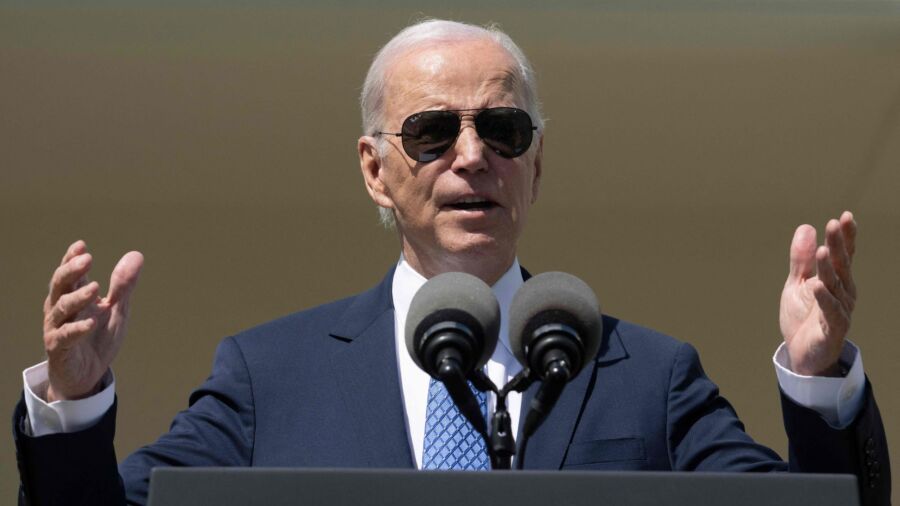Nearly 616,000 public-sector employees have had their student loan debts forgiven since October of 2021 after President Joe Biden’s administration temporarily loosened the rules on the Public Service Loan Forgiveness (PSLF) program.
The U.S. Department of Education (DOE) announced that in total, $42-billion-worth of loans have been forgiven under the Biden-era PSLF rules—a total that represents around $68,000-worth of loans forgiven for each of the nearly 616,000 public-sector employees involved. Some 610,000 people have already had their student loans discharged, and another 6,000 will soon see their student debt erased.
Under the normal policies, the PSLF program allows for the forgiveness of all student loans after a 10-year period of qualifying public sector employment—as long as the public sector employee made their monthly payments through a qualifying loan repayment plan. The temporary Biden-era PSLF rules allowed for previously ineligible loan types and payment plans to count toward the 10 years of loan payments needed to qualify for full loan forgiveness through the PSLF program. The temporary rules allowed public sector employees until October of 2022 to apply for a PSLF waiver.
Only about 7,000 public sector employees had qualified for loan forgiveness under the PSLF program prior to the Biden administration’s rule change.
“These changes are important steps toward a better and stronger PSLF program, one that will move away from the current situation in which too few borrowers receive forgiveness, and too many do not receive credit for years of payments they made because of complicated eligibility rules, servicing errors, or other technicalities,” the DOE stated in October of 2021.
On Monday, Education Secretary Miguel Cardona credited the Biden administration with working to “fix a broken student loan system,” including through its temporary changes to the PSLF program.
“The difference that Public Service Loan Forgiveness is making in the lives of hundreds of thousands of Americans reminds us why we must continue doing everything we can to fight for borrowers and why families cannot afford to have progress derailed by partisan politicians,” Cardona said.
Biden’s Student Loan Plans
The temporary expansion of PSLF eligibility is part of a broader effort the Biden administration has taken to wipe out student loan debt. In total, the Biden administration has taken credit for $66 billion in targeted loan relief to approximately 2.2 million borrowers.
In addition to the $42 billion in student aid through the temporary PSLF eligibility rules, the administration has approved $9.1 billion in relief for 425,000 borrowers who have a total and permanent disability. Another $14.5 billion in borrower defense claims have been approved to around 1.1 million borrowers who argued their schools cheated them out of their promised education. The Biden administration has also provided another $1.26 billion in closed school discharges to 107,000 borrowers who attended the now-defunct ITT Technical Institute.
Another Biden administration plan calls for forgiving up to $20,000 in federal student loans for individuals earning less than $125,000 a year and families earning less than $250,000 a year. Around 43 million people may be eligible for Biden’s debt forgiveness plan. The DOE has estimated the plan would cost about $300 billion over ten years, while the Congressional Budget Office (CBO) estimated it will cost about $400 billion over the same time period.
The Biden administration has argued that student loan debt is a “lifelong burden,” and that federal debt forgiveness is needed to alleviate this burden. His administration has argued the plan would also help address wealth inequality and “advance racial equity” by alleviating a disparity between black and white students.
Criticism
Critics have attacked Biden’s student debt forgiveness plan on multiple fronts.
Some detractors have argued the plan punishes those who saved for college, worked through their time in school, and pursued less extravagant higher education. The Committee for a Responsible Federal Budget has said that “student debt cancellation is regressive and disproportionately benefits those with advanced degrees who are much less likely to be unemployed compared to those with less education.”
The conservative Heritage Foundation has also predicted that canceling student debts will just lead colleges to increase their tuition rates—because students will have more access to funding.
The Biden administration’s student debt forgiveness plan is also facing legal challenges, with critics saying Biden lacks the legal authority to excuse debts. The debt relief plan is currently on hold while the U.S. Supreme Court weighs the legality of the program.

